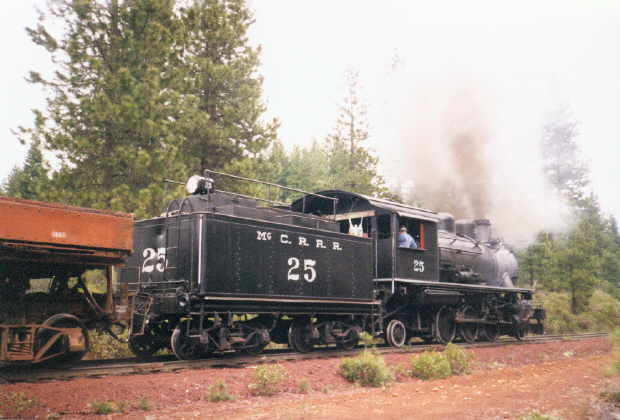|
McCloud Rails : Passenger Operations:
Steam Locomotive #25 |
|
|
 |
|
Bartle, CA, 5/1998. |
|
|
| The McCloud River Lumber Company decided to change it’s operational patterns in the mid-1920’s. Previously, the lumber company had used portable log camps that moved with harvest operations. The lumber company decided to go with larger, more permanent log camps, with loggers commuting to the harvest sites. Concurrent with this decision was the purchase of large blocks of timber east of Bartle, greatly expanding the company’s operations. The McCloud River Railroad at the time was relying on three big Mikado-type engines and five small prairies for it’s freight-hauling locomotive fleet. The prairies were getting old and small, as the newest was built in 1904 and was pushing twenty years old. The early locomotives were also proving to be too small to be of much further use to the company. The solution was to buy some bigger power for the woods operations. The first order went to the Baldwin Locomotive Works, which delivered two large modern prairie type locomotives, the #20 and #21, in 1924 at a total cost of $55,000. The railroad was impressed enough with the pair that it wanted more so that the entire fleet of earlier locomotives could be retired. A salesman from the American Locomotive Company showed the railroad plans for more prairies similar to the 1924 Baldwins, and promised that the company could deliver four such machines for $90,000. An order was placed, and through 1925 four such machines, #22-#25, were delivered to the road. The #25 was the highest numbered of the machines and proved to be the last new steam locomotive purchased by the McCloud River Railroad. It was placed into service in the woods and quickly became the favorite locomotive on the logging railroad. The #25 worked for 30 years in the woods, first at Whitehorse, then at Widow Valley, and finally at Kinyon, where it worked it’s final years before being replaced by McCloud River Lumber Company #1, a General Electric 70-ton 600-horsepower diesel switcher, in early summer of 1955. The end of it’s log hauling days did not mean the end of the locomotive, as it was still very young mechanically. The locomotive was rolled out again for use on the grand excursion to celebrate the opening of the Burney branch in July of 1955. After the excursion the locomotive was placed in storage, where it remained as the last steam locomotive on the property. McCloud management responded to growing interest in the machine by bringing the #25 back to life in 1962. The #25 operated again from that year until 1975, hauling several excursions a year, most sponsored by various railfan organizations. Two excursion operators arrived to try their hand at regular steam excursion operations. The Mt. Shasta Alpine Scenic Railway tried their hand in the summer of 1964, but their efforts were not successful. A second group, the Shasta Huffen-Puff, attempted an excursion operation of their own, and they proved successful from 1967 through 1971, when rising equipment and insurance prices finally forced them out of business. The finale for the #25 came in the 1970’s, when it and a full crew was sent to the Tidewater Southern Railroad in and around Stockton, CA for use in the filming of the movie Bound For Glory, a movie about the life of Woody Guthrie. The #25 went back into storage upon it’s return to McCloud. Itel purchased the McCloud River in 1977 and installed Bill Herndon as president. Itel was not interested in owning a steam locomotive, and it ordered Mr. Herndon to sell or scrap the #25 as soon as possible. Mr. Herndon balked at the order, and negotiated back and forth with Itel, eventually receiving permission to put the locomotive on public display in McCloud. However, before these plans could be brought to fruition, the Great Western Railroad Museum approached the railroad with a proposal to lease and operate the #25. Itel was willing, and the #25 returned to service in the late spring of 1982. The #25 went into it’s third career, hauling several excursions a year until 1986. Once again, the final use of the #25 was in a movie, in this case the film Stand By Me. The #25 pulled a short work train that chased the four principle characters of the film across the Lake Britton bridge. Shortly after the end of filming the Great Western Railroad Museum brought a lawsuit against the McCloud River Railroad over some breach of contract issues. Title to the #25 and several pieces of historic McCloud equipment passed to the Great Western Railroad Museum as part of the settlement of the lawsuit. The #25 remained in storage inside the old paint shop building. The new owners of the McCloud Railway focused efforts on getting the steam locomotive back starting in late 1995, and in January 1996 the McCloud Railway took title to the #25. Restoration work commenced shortly afterwards, and the locomotive was back in operation by Labor Day weekend of 1997. The #25 operated sporadically on the McCloud Railway from 1997 to early 2001, when the #18 was returned to operation. The railroad then stored the #25 from February 2001 until the summer of 2007, when a movie production company restored the locomotive to operation and altered its appearance for potential movie work. However, the movie work fell through, and in the summer of 2008 the railroad returned the #25 to its original appearence. The locomotive then powered a couple of special excursions in October and November of 2008. The railroad then placed the locomotive up for sale. In February 2011 the Oregon Coast Scenic Railroad completed a deal to purchase the #25, and they moved it from McCloud to Garibaldi, Oregon, where it is now in service..
|
|
|